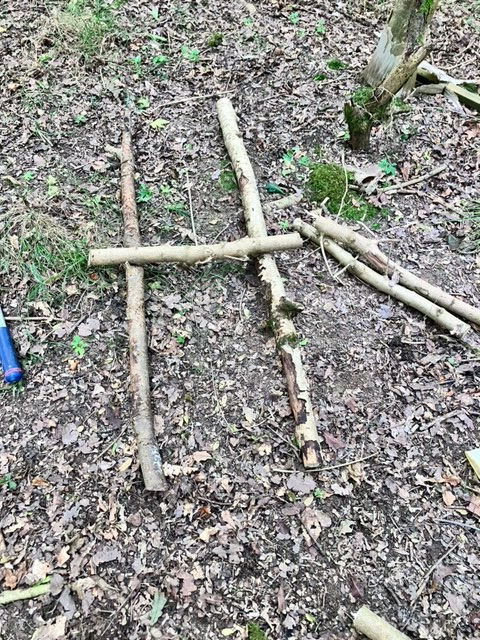1.6- Assignment (Unit 2): Erect a temporary shelter, using tarpaulin and ropes
- Naomi Harvey

- Aug 21, 2024
- 3 min read
Kit Shelter
I decided to make a Kit Shelter for this assignment.
Tools needed:
Tarpaulin
Guy Ropes
Rope
Tent Pegs
Sticks found in the area
A kit shelter is often the first shelter that would be erected in bad weather to keep all kit dry. The shelter has a drop back to protect from wind or rain and two sticks holding it up at the front for easy access to our kit.
I chose a space that was between 2 trees about 10 feet apart and clear ground underneath. I started off by tying a rope from one strong tree to another. I used a Timber hitch on the first tree to secure this tightly about waist height, I then took the rope to the second tree and tied this on using a tension knot, to make sure I would be able pull the rope taut to create a strong holding ridgeline.


With the rope in place, I draped the tarp over the top, making sure it was central and able to reach the ground at the back.
I started off by using two sticks of similar height ,found in the forest, to prop up the front, using a clove hitch to attach the tarp to the sticks using my guy ropes, then pulling them forward and tight and secure with pegs.

Then using tent pegs to secure the two corners at the back, due to it being quite windy, I placed a peg in the centre as well to make sure it was secured to the ground.
I did learn that I need to tighten the tarp next time a bit more and make sure it is spread out tightly next time.

Low Shelter

As demonstrated by Katherine, also completing this course and a colleague.
A low shelter is a small simple A frame tent, protecting you from rain, wind or sun, It is a perfect shelter if you need to teach under bad weather or to create a fun den!
Tools Needed:
Tarpaulin
Guy Ropes
Rope
Tent Pegs
Sticks found in the area
Choose a space between 2 trees no more than 10 feet apart and clear ground underneath. Start off by tying a rope from one strong tree to another. I would suggest using a Timber hitch on the first tree to secure this tightly about waist height, then take the rope to the second tree and tie this on using a tension knot, to make sure you would be able pull the rope taut to create a strong holding ridgeline.
With the rope in place, drape the tarp over the top, making sure it is central and equal amount of tarp on both sides.
On each corner of the tarp, place a stick in the eyelet hole using a clove hitch and secure the stick and tarp using a guy rope. Use the guy lines to secure each stick by pulling out and securing with pegs. I would suggest not to make them too tense to begin with until you have secured all four corners, once all tied down, move around your shelter and create more tension in each corner.
High Shelter
A high shelter is a shelter high enough for us to stand underneath. It can be also used to shield a fire from rain.
A high shelter starts off the same as a kit shelter, but you raise the ropes on the trees high enough that when the tarp is placed on top you can stand underneath.
Use taller sticks but secure the same as before, clove hitch with guy ropes being secured to the ground with pegs, make sure tension is created on guy ropes.

Comments